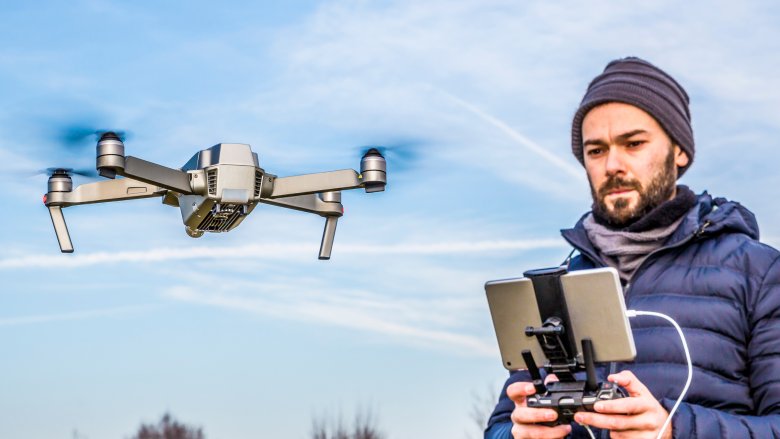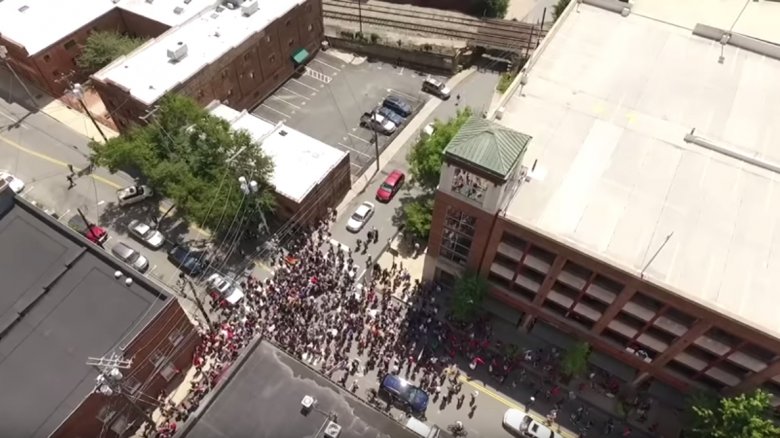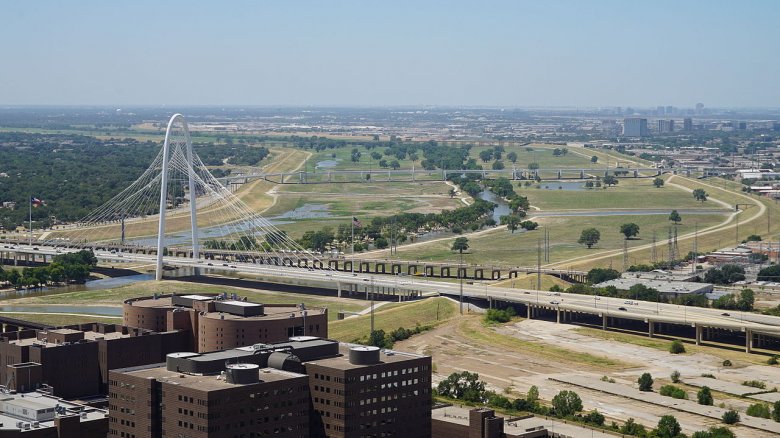Spine-Chilling Things Caught By Drones
Drones might just basically be a camera attached to a tiny helicopter, but they seem like the futuristic technology we were promised as children (not that we're bitter about the lack of hoverboards.) And in just a few short years, drones have become a part of everyday life, like mechanical bees buzzing all over the place. Compared to doing aerial photography with an actual regular-sized helicopter or something, they're far cheaper, much easier to fly, and way more practical. Just pick one up from the store and you can see the world from a whole new vantage point.
But sometimes, what you see may be something you wish you hadn't. From natural phenomena seen from a brand new angle to things that are just plain weird, drones have captured footage of some very chilling stuff. Here's a bunch of the truly spine-chilling things caught by drones (with a little help from humans.)
A tour of a creepy abandoned building
Abandoned buildings have their appeal. Check out any urban exploration ("urbex") groups on the internet and you can see dilapidated and condemned buildings, no longer occupied but not yet demolished. The big downside of exploring abandoned buildings is that it's, well, kind of dangerous. Between hurting yourself on broken building materials or collapsing structures and possibly winding up in jail, looking around a trashed old building may not be the best thing you could do with your time. And that's not to mention all the ghosts that would clearly make these places their homes. Like, obviously.
Thankfully, we have drones now. In an award-winning video, filmmaker Lukasz Lewenda uses a GoPro attached to a drone to explore the nooks and crannies of some forsaken, spooky place. It's actually not entirely clear what the building was before it fell into disrepair. It looks like it could have been a factory, but then other areas seem like classrooms and things of that sort. Nature has overtaken some spots, and greenery flourishes next to broken concrete and tagged walls. It's quite eerie, and that's even in broad daylight. Just imagine how terrifying this place would look in the dark.
The Charlottesville car attack
On August 12, 2017, a "Unite the Right" rally in Charlottesville, VA was countered by a large group of peaceful protesters who opposed the white supremacist and neo-Nazi views of many of the rally attendees. The rally itself was in response to plans to remove a statue of Robert E. Lee from Lee Park (since renamed Market Street Park). At the time, many Confederate monuments and symbols were being removed from public spaces across America, and various far-right groups who were upset at this trend decided to try to come together under a single banner, hence the "Unite the Right" moniker.
That afternoon, a neo-Nazi and white supremacist named James Alex Fields, Jr. drove his car into a group of protesters, injuring approximately 30 people and killing one, Heather Heyer. The event, witnessed by several hundred people, was also filmed from multiple angles, including by a drone camera that happened to be hovering overhead.
The video only shows an obscured view of the attack, but is still graphic and shocking. Fields struck a white sedan, which, in turn, was slammed into a red minivan, the only vehicle shown clearly in the video. Still, it does make your blood run cold to see people scattering to get out of the way of the horror. In 2019, Fields was convicted of first-degree murder (among other offenses) and sentenced to life in prison.
The aftermath of a tsunami
On September 28, 2018, a 7.5 magnitude earthquake struck near the Indonesian island of Sulawesi. While the earthquake did minimal damage, it triggered what was thought to be a small tsunami. Shortly after the tsunami, experts found that in Palu, the capital of the Central Sulawesi province, waves reached 20 ft., more than double the initial estimates, according to Scientific American.
Central Sulawesi is located on a very long and narrow bay (only about 20 miles wide), so the tsunami moved quickly through the area, sweeping across the land and dragging tons of rubble directly into the ocean on the other side of the bay. The ground also became heavily saturated, leading to large mudslides that only added to the destruction. In total, the tsunami, one of the largest to hit Indonesia in more than a decade, killed over 4,300 people.
Within days of the disaster, drone footage of the city began to emerge. Seeing the ruin from above, you can understand the scope of what happened. Bridges lay collapsed, houses are little more than debris, and some areas are still underwater. Then, of course, there are the people of Palu as they prepare to rebuild their city.
A live tornado
Not only do storm chasers bring us jaw-dropping video and photos, but they also help us learn more about tornadoes: how they move, the conditions that can spawn them, etc. And drone videos of live tornadoes are a thing you'll be seeing more of in the future. Note: you shouldn't do this with a regular drone, and if a tornado is coming, please get away from it. This video was made by someone who knew what they were doing and had a drone that could handle it.
Everyone's seen videos of tornadoes shot from the ground, and while they're scary enough, seeing one from the air is simultaneously horrifying and awe-inspiring. Thankfully, this particular tornado, shot near Sulphur, OK in April 2019, wasn't terribly destructive, and the video is mostly just trees and small fences being flattened and tossed aside as the twister churns along. Early on in the video, you can see some semi trucks and a cell tower nearby to give you a sense of the scale of the cyclone.
An active volcano
If you've ever seen a video of a volcano, you've probably seen one of two kinds. In one, slow-moving lava flows down a hill and melts whatever is in its path. In the other, the volcano is violently erupting, but the footage is filmed from a very long distance away because volcanoes are dangerous and safety is important.
The reason we don't have many videos of lava bubbling inside a volcano's cone is two-fold. It's typically too hot for most cameras, and it's definitely way too hot for people (and that's not even getting into the toxic gases). The ambient temperature inside a volcano can get hot enough to instantly light people on fire, even if they're not touching any lava. Star Wars: Episode III should have actually ended with both Anakin and Obi-Wan bursting into flames when they got close to those rivers of lava.
Technology is saving the day, though. Drones that are resilient to the extreme heat can now fly into volcanoes and take videos like the one above, which is really helpful to volcanologists. Since the human pilot can be a good distance away, they also eliminate that whole fiery death part of the equation. The drones don't always survive, but at least the people piloting them are just fine.
A huge forest fire
We typically we see dozens of forest fires threatening people and property every year now, and they get larger and larger to boot. While there's never a shortage of video of wildfires, they're often taken from the ground or from a helicopter, which naturally can't get too close. Enter drones. While they might have similar problems to helicopters, like choppy air and visibility issues, they can get closer and still be far safer than a helicopter full of people.
In this clip, it looks like a standard nature video until the drone flies above the treeline, where you can see smoke on the horizon. When the drone moves in for a closer look, though, you get a sense of the breadth of the fire. A huge swath of trees burns and the smoke fills the sky. While the scale of this particular fire is not as big as some of the wildfires we've seen on the West Coast in recent years, it still looks enormous and gives a sense of scale for those massive fires.
While these drone operators did specifically go out to film this fire, that's probably not the wisest idea, and you shouldn't get close to large fires of any kind. Don't wreck your drone, endanger yourself, or get in the way of firefighting efforts, kids.
Someone climbing a 1,500 foot broadcast tower
You probably see cell phone towers every day, right? You ever wondered how the stuff at the top gets installed or maintained? Turns out, it's usually someone who just straight-up climbs the tower. Now, a cell phone tower is typically around 200 ft. tall, which is pretty high up, no joke. But what about a 1,500 ft. broadcast tower? There must be some special way of doing maintenance on those, you might be thinking. Nope! It's the same story. Somebody very calm under pressure scales the whole thing to work on that equipment. It's basically a free climb, too. While the climbers do have some safety equipment, a lot of the heavy-duty stuff is, well, heavy.
This video shows one of these climbs thanks to the magic of drone technology, and even if you're not scared of heights, there's an excellent chance this would still make your skin crawl. For reference, the free climb is over a quarter of a mile straight up. If you don't count the tip of Willis Tower (formerly Sears Tower) in Chicago it measures 1,450 ft., so this tower is actually 50 feet taller. That's a real long way up, and basically guaranteed to freak out a large chunk of the population.
An escaped convict
In 2002, Song Jiang, a Chinese man convicted of human trafficking, escaped from prison and then effectively vanished. He hadn't been spotted for 17 years when police received a tip he was living somewhere in the mountains of Yunnan province, not far from his hometown. Police found the terrain too treacherous to search on foot. Instead, in September 2019, they took to the sky and flew a drone over the area, and that's when they spotted where this horrible, creepy criminal was hiding out.
Police approached the area on foot and it got even creepier. According to CNN, Jiang had been without human contact for so long, when authorities tried to speak with him, he was unable to communicate with the officers. Police did confirm it was Jiang and re-arrested him. According to NBC News, inside his cave, they found numerous blackened pans, layers of bedding, and evidence he had been cutting his own hair. It also seemed Jiang hadn't bathed or washed his clothes in "a long time."
Jiang has since been returned to prison. Still, we can't shake the fact someone convicted of a horrible crime was able to hide out in the mountains for 17 years just outside of human civilization and become a creepy, partially-mute hermit in that time. Thanks, drones!
An actual river of blood
Normally relegated to the book of Revelation or horror movies, rivers of blood aren't a thing you ever expect to really see. So that was probably not something David Mimlitch anticipated when he flew a homemade drone over the Trinity River in Dallas, TX in 2011. Mimlitch went out on his lunch break, flew around, and snapped a few photos, according to D Magazine. There's no video for this one, but that's probably a good thing, honestly, because it turns out a for-real river of blood is exactly as horrifying as you imagine it would be.
Mimlitch returned to work and looked at some of the photos he'd snapped on the flight. That's when he spotted a dark red section of the river. Mimlitch thought it might be blood, but quickly dismissed the idea as crazy. Still, he contacted the National Response Center, who investigated and found the river was indeed contaminated with blood. Pig's blood, specifically, which came from the Columbia Packing Company, a meat packing company located upriver, who were illegally dumping tremendous amounts of pig blood directly into the river instead of disposing of it properly.
In the end, Columbia Packing Company was ordered to pay a $100,000 fine. It likely would have been worse, but the state's case got sunk by an overeager Dallas County Health and Human Services investigator that trespassed on Columbia's property to snap more photos.
A friendly neighborhood cornfield clown
"What this cornfield needs is a really freaky clown to just stand around for... no real reason, actually," said no one ever. And yet, here we are. In this video, a young pilot was doing a flyover of a large cornfield when he spotted something bright orange. He takes a closer look at what appears to be a creepy scarecrow, which then turns to look at the drone. Scarecrows don't move, right?
Instead of being a regular thing to scare birds away, it's a human being who will scare anything away. Someone dressed in a clown mask with a bright orange shirt is just hanging out in the cornfield. The clown is alerted to the drone's presence and actually books it, which makes you wonder just what he was up to down there anyway. The clown flees into some woods and the pilot, presumably not wanting to try to navigate through low-hanging trees, opts not to follow. Creepiest of all, when he flies the drone back to where he's at, he's not all that far away from where the clown vanished.
On the real, this could certainly be a setup. The clown could be a friend of the pilot's and they planned the whole thing. But even if that's the case, the video is still effective at ensuring you'll never sleep within several square miles of a cornfield ever again.
An angry farmer with a gun
Not everyone is thrilled about drones. They're somewhat noisy and bothersome, and that's not even touching on the privacy and other legal issues involved. So you sometimes hear stories of people shooting at drones (which is illegal in many parts of the world).
This particular encounter is a bit scary, though. A farmer, presumably fed up with drones, slowly walks toward a drone flying on his property, loads a double-barrel shotgun, takes aim, and fires exactly once, bringing the drone to the ground. A slow-motion replay is even scarier, showing the farmer looking a bit like the Terminator as he loads his shotgun.
Err... that's what the video seems to show, anyway. Some commenters have called the video out as a fake, noting the muzzle flash looks very unrealistic, there's no smoke coming from the gun, and there seems to be a bit of a continuity error, as the man throws his cap before shooting at the drone, but after the drone is hit, it catches sight of him again and the cap is back on his head. It seems like an odd thing to fake, because there are plenty of news reports of people being arrested for doing the exact same thing, and it wouldn't be difficult to film it for real, though you'd presumably be out one drone and a few shotgun shells. It is a mildly disturbing video, but it would be even more effective if it was definitively real.
A shark catching its prey
Sharks have officially been scary since 1975. Before that they were merely unofficially scary. People film them all the time, but drone footage from the Discovery Channel is a whole other level of creepy. A crew of researchers uses a drone to film sharks from above due to the water being cloudy, and captures one doing what sharks are best at — getting ready to eat.
Seen from above, the shark hunts for seals, which normally hide near the rocks close to the shore to avoid this very situation. However, due to a high tide, the shark can maneuver the rocks easily. The film crew can tell what's going on from the shark's behavior, and they brace themselves for marine predator lunchtime theater.
A seal, seemingly unable to detect the shark's very close proximity, swims directly toward its hungry enemy. Within seconds, the shark darts forward and attacks, and moments later, blood surrounds the two in the water. It then begins shaking the seal, and though the experts in the crew assure us the seal was probably already dead, it's still very sobering to see, especially since the animals had no idea they were being watched (and the crew wasn't in any danger of being eaten themselves.)



